Netflix, Amazon Face New Parameters and Challenges in Europe

In their quest for global domination, Netflix and Amazon view Europe as a key battleground. Both companies have dramatically ramped up operations on the continent in recent years to woo subscribers, creatives and talent.
But tensions over content, costs and consequences for the region’s legacy players have been building, and in some cases have boiled over. Europe’s lawmakers are stepping in to regulate the streaming behemoths’ activities, while traditional players gear up, and even unite, to check the rise of upstart companies that some of them have been only too happy to work with.
Looming large over the U.S. streamers is a new requirement that 30% of their content be sourced from within Europe. The quota was approved in October by the European Parliament amid fears over the level of investment in European fare as American players gain ground.
The rule does not come into force for at least a year and a half, but both Netflix and Amazon have work to do to meet it. Data compiled by London-based Ampere Analysis and shared with Variety show that, as of July, Netflix was behind Amazon in France and Germany in the race to 30% European titles. The situation is reversed in Italy, and in Spain and the U.K., the two rivals are neck and neck. In real terms, Ampere calculates that Netflix needs, for example, more than 3,000 additional hours of European content in France, while Amazon needs more than 1,800 additional hours in the U.K.
Netflix says it’s already headed in the right direction. “It doesn’t significantly alter our strategy in the sense that our goal is to have more shows out of Europe regardless, because that’s what our members want,” Erik Barmack, Netflix’s VP of international originals, said at a conference in London last week.
But Netflix and Amazon executives say privately that planning is tough because it remains unclear how the quota will be enforced and measured – by number of hours, number of episodes or some other metric.
Regardless, the big streamers will need to achieve a higher proportion of European fare, either through ordering more originals, acquiring new shows or reducing the amount of non-European content. “The reality is it will be a combination of all three,” says Guy Bisson, Ampere research director. “The upside for producers and distributors is that there is bound to be, to some degree, a commissioning and acquisitions bonanza to bring the catalogs up to the required level.”
The flip side is that by going more local, the streamers become yet fiercer competition for established players.
Up to now, European broadcasters have eyed the U.S. giants warily and, at the same time, eagerly entered into co-production deals as the streamers try to beef up their locally sourced content and get access to local talent and ideas. It’s useful for the broadcasters to have deep-pocketed partners that can help cover the rapidly rising costs of high-end drama production, while the streamers get shiny new shows they can launch around the world, except in the broadcasters’ home territories.
“Increasingly, TV networks need Netflix and Amazon to buy SVOD rights in order for shows to get financed, even if [the networks] don’t like it,” says Pascal Breton, CEO of Federation Entertainment, which produced Netflix’s first French original, “Marseille.”
Broadcasters now fear the well is about to run dry. The huge growth in the number of the streamers’ wholly owned originals dwarfs the level of co-production. Barmack said recently that the number of Netflix’s European originals will increase from 141 to 221 next year, with wholly owned titles rising from about 57% of the total to nearly 70%. The company is building a massive European production hub near Madrid.
Georgia Brown, Amazon’s European content chief, told the Royal Television Society last summer that Amazon does not want to tread on local players’ toes, but rather offer audiences something they might not be getting elsewhere. “We’re looking at the white space,” she said. “We’re not here to take over.” She assured listeners that Amazon would “continue to invest heavily in the co-production side,” but added: “I can’t comment [about] five years in the future.”
Peter Kosminsky, one of Britain’s best-known writers and directors (“Wolf Hall”), says the co-production model has already broken down. “There’s evidence here and in Los Angeles that the period in which the SVODs were prepared to co-produce with British public-service broadcasters was a transitional period,” he said recently at an industry event in London. “Their basic business model requires them to own the entire IP, to win it all – no back-end participation, no co-production.”
Kosminsky wants to see the streamers pay into a fund for creating the public-service fare that pubcasters are required to make but commercial platforms are not. “Where is the money? It lies in the very deep pockets of the SVODs who are happily broadcasting into our environment sans regulation,” he says. “I’d like to see some of that money siphoned off to protect the kind of broadcasting that we treasure.”
Officials have already moved in France and Germany to impose levies to boost local film and TV funds. Netflix recently agreed to start paying a 2% tax on its annual revenues in France, and just wrote its first check. Its appeal of a new levy in Germany was rejected by a European court.
The traditional broadcasters are also teaming up to take the fight against Netflix and Amazon onto the streamers’ own turf. British media regulator Ofcom has urged U.K. broadcasters to band together to launch a unified streaming service. France Televisions, TF1 and M6 have already aligned to create a new one-stop service, Salto. In Germany, ProSiebenSat.1 and Discovery are asking broadcasters to join their new platform.
The competition for talent is another battlefront. Netflix has inked deals with Spain’s Alex Pina (“Money Heist”) and Germany’s Jantje Friese and Baran bo Odar (“Dark”); Amazon has signed up Neil Gaiman. But such relationships aren’t right for everyone, says Fredrik Wikstr?m Nicastro, producer and senior VP of international production at Swedish production company SF Studios. “Unless the writer has a high profile, the upfront fee he or she will negotiate with Netflix will probably not be as lucrative as getting paid by a broadcaster and receiving back-end [payments],” he says.
For the streaming giants, the fastest way to help meet the looming 30% quota in Europe will be to go on a buying spree. Drama, comedy and kids’ content will likely top their shopping lists. “Netflix is looking for shows that are for young audiences and lots of genre, as well as romantic series,” says Federation’s Breton. “They’re not chasing big stars. What they want is a lot of shows, not expensive, and skewing to young demos.”
But distributors need to tread a fine line between their old and new customers. “Sales agents are walking on eggshells because local broadcasters are their primary clients, so they are being cautious to not alienate them,” one sales veteran says.
Barmack envisions a future in which the global audience for European and other originals is bigger than the population of the country where they originate. Europe’s old guard wants to dominate on their home turf. But as the TV industry globalizes, not everybody can be a winner.
Related stories
Netflix Signs First-Look Deal With Chris Columbus' Production Company
Comcast X1 Launches Amazon Prime Video Starting This Week
'Narcos: Mexico' Renewed for Season 2 at Netflix
Subscribe to Variety Newsletters and Email Alerts!
Solve the daily Crossword

